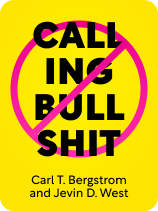

This article is an excerpt from the Shortform book guide to "Calling Bullshit" by Carl T. Bergstrom and Jevin D. West. Shortform has the world's best summaries and analyses of books you should be reading.
Like this article? Sign up for a free trial here.
What’s a reductio ad absurdum? When and how should you use this useful logical construct?
In Calling Bullshit, Carl T. Bergstrom and Jevin D. West contend that anyone can learn how to identify and refute bullshit in its many forms. One way to call bullshit is to construct a reduction to absurdity. It’s also helpful to know how to respond when someone uses a reduction to absurdity with one of your claims.
Keep reading to understand this handy tool and get some practical advice on how to use it to get closer to the truth.
Construct a Reductio ad Absurdum
Bergstrom and West explain that a reductio ad absurdum (“reduction to absurdity”) can be a powerful tool for exposing bullshit. Constructing a reductio ad absurdum involves showing that a claim has an obviously false consequence and thus logically cannot be true. For example, imagine that you read an op-ed arguing that parents should have absolutely no restrictions on how they choose to raise their children. In this case, you could construct a reductio ad absurdum pointing out that this op-ed’s view implies that parents should have the right to abuse or neglect their children. Because this implication is ridiculous, the original view must be false.
| How to Respond to an Alleged Reductio ad Absurdum According to philosophers Walter Sinnott-Armstrong and Robert Fogelin, there are three primary responses available to you when you’re faced with a supposed reductio ad absurdum of one of your views. First, you can flatly deny that your view has the absurd consequence that your critic alleges. For instance, when utilitarians—those who believe that actions are morally permissible if and only if they cause the greatest net pleasure—are faced with absurd consequences of their view, they often deny that their view has these consequences. Critics object, for example, that utilitarianism entails it would be permissible for a sadist to murder someone if he derived enough pleasure from it, but utilitarians might respond that in practice, allowing a sadist to murder someone would cause widespread panic that doesn’t maximize net pleasure. Second, you can make slight adjustments to your view so that it no longer has an absurd consequence. Returning to the example of an op-ed that argues parents should have no restrictions in raising their children, the author might instead tweak their view and claim that parents should have minimal restrictions on raising their children so that they aren’t committed to allowing child abuse. Finally, you can “bite the bullet” and accept the consequence that others allege is absurd. For instance, if our author truly was committed to the radical view that parents should be able to raise their children however they see fit, then they might bite the bullet and admit that parents should be allowed to neglect their children. Because biting the bullet can require accepting unpalatable consequences, it’s generally best as a last resort. |

———End of Preview———
Like what you just read? Read the rest of the world's best book summary and analysis of Carl T. Bergstrom and Jevin D. West's "Calling Bullshit" at Shortform.
Here's what you'll find in our full Calling Bullshit summary:
- That misinformation online, in news, and in academia is spreading
- How to detect and refute bullshit in its many forms
- How data can be miscollected and misinterpreted in science






